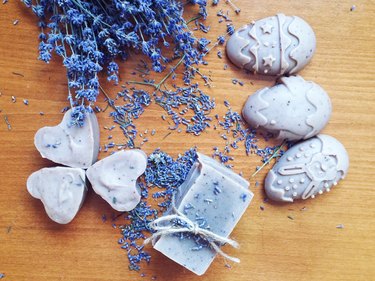
Sodium palmate and sodium cocoate are both key ingredients in the soap-making process. Before scent or other ingredients are added, base soap is nothing more than the sodium or potassium salt of a fatty acid. Through a chemical process called saponification, sodium palmate and sodium cocoate are formed as a result of the reaction between a fatty acid and sodium hydroxide or potassium hydroxide. The mixture can then be cooled and formed into soaps.
Tip
Sodium palmate and sodium cocoate are both key ingredients in the soap-making process. They are formed as a result of the reaction between a fatty acid and sodium hydroxide or potassium hydroxide.
Video of the Day
About Sodium Palmate and Cocoate
Sodium palmate is synthesized by reacting palm oil with sodium hydroxide through a process known as saponification. In saponification, a fatty acid reacts with an alkali. With sodium palmate, palm oil is the fatty acid and sodium hydroxide is the alkali. The byproducts of this chemical reaction are glycerol and sodium palmate, a surfactant and emulsifying agent and a key ingredient in soap.
Video of the Day
Similarly, sodium cocoate is produced through the reaction of coconut oil with sodium hydroxide. You may see sodium cocoate referred to on package labels as coconut oil, fatty acids, coco and sodium salts. It is also a surfactant and emulsifying agent. Like sodium palmate, sodium cocoate is a key ingredient in soap making.
How Soap Is Made
Handmade soap is created through either a hot or cold process or from a ready-made soap base. The process begins by adding lye to water, and in so doing, the solution becomes hot. Lye is a caustic material that can cause severe burns if it comes in contact with skin. Therefore, protective gear is required in the handling of lye or incomplete soap.
In cold-process soap-making, the lye solution is cooled to room temperature, and the oil is heated to melt any solid fats, then cooled to approximately 80 to 100 degrees. The lye solution and oil is then mixed together, causing the saponification process where the oil and lye chemically react to become soap. No added heat is used during this soap-making process, hence the name "cold process." Lastly, the mixture can be poured into molds, cooled and cured as the finished soap product.
Hot-process soap-making is similar to cold process, but an external heat source is applied to the oil and lye mixture to speed up the saponification process. Ready-made soap bases speed up the soap-making process even further, as all of the soap-making steps have already been completed. These bases can simply be heated and any additional colors, scents or small trinkets added to the soap prior to the molding process.
Read more: Tea Tree Oil Soap Benefits
Soaps Vs. Detergents
Sodium palmate and sodium cocoate are found in soaps — which are different from detergents, even though they both have emulsifiers and surfactants. Soaps are made from fat or vegetable oils that have been saponified with sodium or potassium hydroxide. Some manufacturers also add other ingredients such as scents and botanicals. Detergents use different surfactants and are generally categorized as synthetic cleaners in a variety of products, including personal hygiene, dishwashing, laundry and dry-cleaning solutions.
If you're concerned about the ingredients used in your soap, detergent or other everyday products, check with the manufacturer and read ingredient labels. Some manufacturers may add more synthetic chemicals to their products, while others commit to making their products without any potentially harmful ingredients. Cosmetic products and ingredients do not require the approval of the Food and Drug Administration, so it's important to check on the safety of your soaps and beauty products.
The makers of Alaffia products, for example, include a Made Safe seal to guarantee that Alaffia products are made without any ingredients known or suspected to harm humans, animals or ecosystems. In addition to Alaffia products, you can find other Made Safe soaps and products on the Made Safe website.
The Legend of Soap's Discovery
According to legend, soap was first discovered by washer women who did laundry in the Tiber River at the base of Sapo Hill in Rome. Sacrifices were made on Sapo Hill, so the rainwater running down the hill was rich in potassium hydroxide derived from the potash in the ashes from the fires and animal fat from the sacrifices. The word "saponification" is derived from "Sapo" Hill.
- Toxic Free Foundation: "Ingredient Database: Sodium Palmate"
- Toxic Free Foundation: "Ingredient Database: Sodium Cocoate"
- New World Encyclopedia: "Soaps and Detergents"
- New World Encyclopedia: "Soaps and Detergents: History"
- Handcrafted Soap & Cosmetic Guild: "How Is Soap Made?"
- Alaffia: "Alaffia's Commitments"
- Made Safe: "Personal Care"